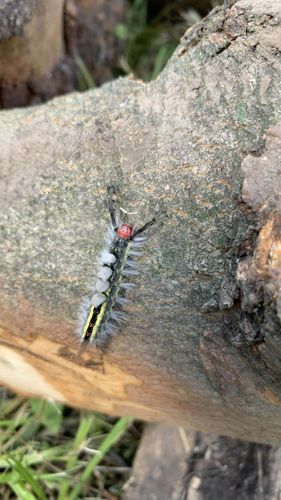Tussock Moth Caterpillar (likely White-marked Tussock Moth caterpillar, Orgyia leucostigma)
Scientific Name: Orgyia leucostigma (most likely species given the appearance in the image, but definitive identification without further examination is difficult, as other Orgyia species look similar).
Order & Family: Lepidoptera (Order), Erebidae (Family) - specifically within the Lymantriinae subfamily, which are the tussock moths.
Size: Caterpillars typically range from 2.5 to 3.5 cm (1 to 1.4 inches) in length when fully grown.

Natural Habitat
Forests, woodlands, orchards, urban and suburban areas with suitable host trees and shrubs.
Diet & Feeding
Herbivorous. Caterpillars feed on the leaves of a wide variety of deciduous and coniferous trees and shrubs. Common host plants include oak, maple, birch, willow, apple, spruce, pine, and fir.
Behavior Patterns
The caterpillar stage is the most conspicuous. They will feed on host plants voraciously before pupating. Adults are moths, which are typically nocturnal, though some Lymantria species can be active during the day. The caterpillars often exhibit a distinctive humped posture when at rest.
Risks & Benefits
Potential Risks: The hairs on tussock moth caterpillars, particularly the urticating (stinging) hairs, can cause skin irritation, itching, rashes, and allergic reactions in sensitive individuals if handled or if contact is made through the air. They are considered pests when populations are high, as heavy defoliation can stress or kill trees. Potential Benefits: They are a food source for birds and other predators. As part of a diverse ecosystem, they contribute to the food web. Adult moths can play a minor role in pollination.
Identified on: 8/31/2025